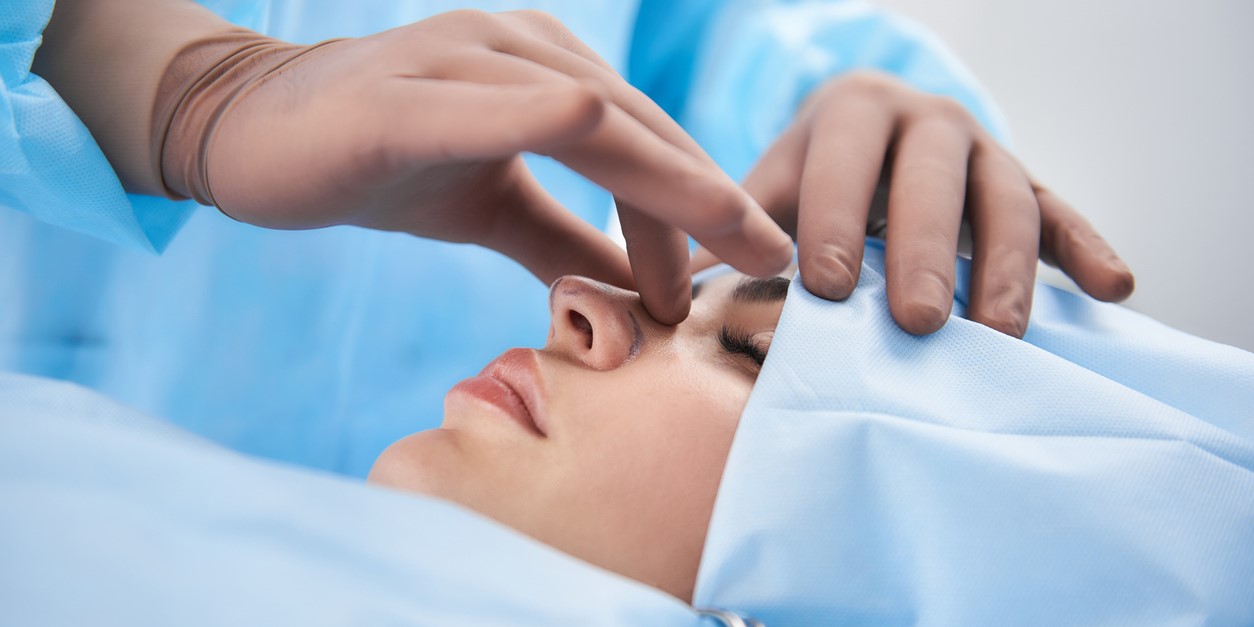A nose job helps widen nasal passages, improve airflow, and alleviate breathing difficulties and other respiratory conditions.
Published Aug 16, 2024 | 10:00 AM ⚊ Updated Aug 16, 2024 | 10:00 AM

Surgeon in rubber gloves making rhinoplasty for woman. (iStock)
A rhinoplasty or nose job is performed when someone wants to change their nose’s shape, size, and contour for aesthetic purposes. Still, it becomes a medical necessity when the concerns are associated with breathing difficulties or obstructive airflow caused by a birth defect, ie, deviated septum or a narrow nose, or because of nasal trauma, injury, or accident.
However, rhinoplasty is pivotal in correcting a deviated septum, respiratory failure, and broken nasal bones. A nose job helps widen nasal passages, improve airflow, and alleviate breathing difficulties and other respiratory conditions.
One must hold that apart from functional benefits, reconstructive rhinoplasty surgery addresses the concern of an asymmetrical nose that may sometimes be caused by traditional septoplasty or septal surgery alone.
Therefore, rhinoplasty shares aesthetic and functional importance, and many patients seek the procedure for medical purposes. According to the American Society of Plastic Surgeons (ASPS), over 220,000 rhinoplasty surgeries are performed annually in the US alone. This figure can vary globally due to the prevalence of deviated septum concern.
I want to highlight one of the case studies I have encountered in my rhinoplasty career where a patient had no functional problems but had major and minor septal deviations, which impacted the symmetry of their nose.
In such a specific case, I have performed septorhinoplasty, which helped him better meet the desired results in managing the deviated septum.
However, it requires a thorough evaluation during the introductory consultation to select the best approach to address such concerns. Moreover, an open rhinoplasty approach can help overcome almost all deviations, treating a twisted nose, heavy deformities, S-shaped deviation, and complicated revision cases.
Most patients opt for rhinoplasty surgery when they experience either the need for cosmetic alterations or to correct functional defects.
However, there are no concrete age requirements for rhinoplasty procedures, but functional issues, such as deviated septum or breathing difficulties, can prompt people to seek rhinoplasty at various ages.
Board-certified plastic surgeons suggest waiting until around 18 years old to ensure you are mature enough and your facial features are fully developed.
Still, rhinoplasty in teen patients is crucial to fix issues like breathing difficulties or cleft palate, as a birth defect, ie, deviated septum, is at play here. Based on individualized decisions and customized requirements, I perform rhinoplasty on teenagers as young as 14.
However, teen rhinoplasty for boys can be performed between the ages of 17-18, while girls can go under the surgical correction around 14-15, as menstruation marks the completion of most primary facial growth.
Moreover, rhinoplasty is a highly customised procedure, which is more about developmental and emotional maturity and less about age.
When something is related to cosmetic enhancements or medical necessities, the cost factor should be secondary because every patient is unique and requires a customised rhinoplasty procedure based on their problem status, surgical goals, and extent of the procedure.
Still, the cost of rhinoplasty in Bengaluru is competitive and entirely bespoke to the procedure you need and generally less expensive compared to other metropolitans, such as New Delhi, Mumbai, Kolkata, Chennai, and Hyderabad.
Therefore, introductory consultation is mandatory to know the exact figure in a specific case.
If a lumpsum cost is asked, it may be around ₹75,000 to ₹1,20,000 excluding the taxes concerned.
Surgeons with extensive experience with global recognition and active membership in reputed plastic cosmetic surgery societies, such as ISAPS, IAAPS, and RSE (Rhinoplasty Society of Europe), may charge more for their services.
Every patient heals differently based on their physiology, healing ability, and adherence to post-op care instructions. It is always advisable to follow all the instructions given by your plastic surgeon and attend the follow-up visits as required or advisable.
In most patients, recovery takes six to eight weeks, and post-op effects, such as swelling and bruising, gradually improve over the week.
Your plastic surgeon will prescribe any required medications to keep you comfortable during recovery. A nasal splint is required for support healing, and the new nose contour will be removed five to seven days following your procedure.
Most patients return to non-strenuous activities within a week, and strenuous activities or exercises can be resumed after six to eight weeks, requiring a plastic surgeon’s approval.
Significant reduction in swelling and bruising can be experienced after two to four weeks, and most swelling subsides after one to three months. Final results are generally visible after six to 12 months.
While rhinoplasty is not gender-specific due to its necessity for both cosmetic and medical purposes still there are some gender-specific differences in the incidence and motivation, accelerating the preferences to undergo surgery.
Men require rhinoplasty for a more masculine facial feature; however, the aims are centred around making the nose more pronounced, straighter, and stronger with a pronounced bridge and a broader nasal base.
Women seek rhinoplasty to make their nose more refined and narrower nose to achieve a delicate, balanced appearance that enhances feminine facial features.
Further, these gender-specific indications and considerations may be influenced by various factors, including cultural and aesthetic preferences psychological and anatomical considerations.
Thus, a primary assessment is needed to know the surgical goals and realistic expectations.
(Dr Karishma Kagodu (MBBS, MS, MCh, Plastic Surgery) is the founder of Karishma Aesthetics. Views expressed are personal)
(South First is now on WhatsApp and Telegram)
